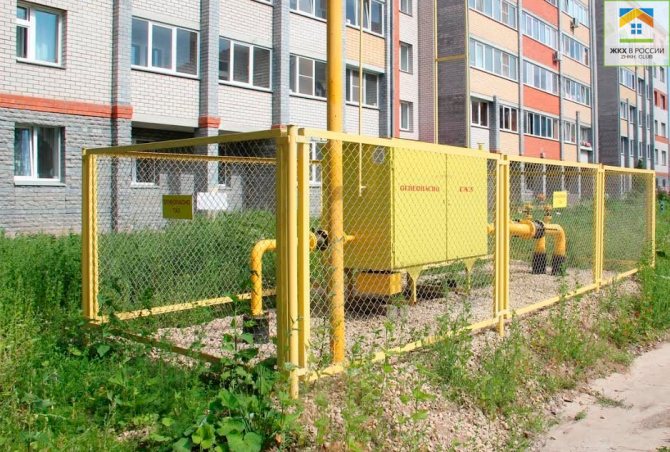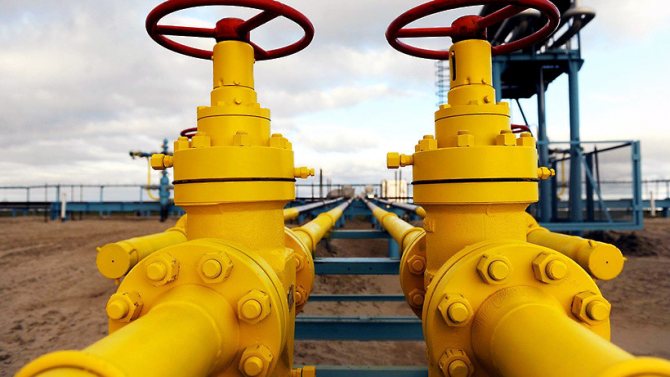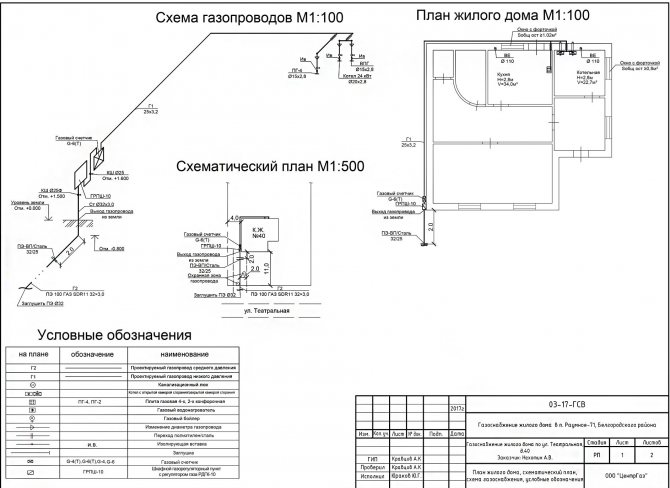Gasification of a private house is a rather expensive and laborious process. However, if you have made the decision to supply gas to your house, then you need to know what is required for this - what permits are needed to gasify the house, what work will need to be done, and how much it will cost.
First of all, you need to find out who is the owner of the gas pipeline (as a rule, it is GorGaz), a meeting with which will determine the possibility of tapping into its gas pipeline. If you received a positive response from him, then the next instance will be the design organization, which will develop and manufacture a project for connecting your house to this particular gas pipeline.
Already with the finished project, you go to the installation organization, which will take on the solution of all problems related to the installation of the gas pipeline. She is also responsible for the commissioning of this section of the gas pipeline, therefore, it must necessarily have an appropriate license to carry out this type of work. It is advisable to carry out all settlement operations with the installation organization only after the site has been handed over to the State Control authorities.
When all of the above steps have been passed, and all stages of the work have been done, you can use the gas for your own purposes and at your discretion.
But let's look at in order how to start gasification at home and what you need for this.
First stage. A set of documents for gasification of a house
- permission of the heads of the architectural and planning department (APU) for gasification of a private house;
- a copy of the technical passport of the Bureau of Technical Inventory (BTI) for a private house;
- topographic survey of the site with the landing of the most private house and gasified structures on the site at a scale of 1: 500 with applied communications and a gas pipeline, certified by the local gas service;
- written permission from neighbors to connect to the gas pipeline, if it is laid along their sections (however, as a rule, such permission must be obtained from GorGaz, since it is he who in most cases is the owner of the gas pipeline).
New rules for connecting gas to a private house: procedure and cost
Gasification of a private house has a number of undoubted advantages, and the most significant of them is gas heating and water heating, which are much lower in cost than other options. For example, electric heating will come out to the owner of the house about 10 times more expensive than gas. The owner of the house can install a gas tank and not depend on the central highway. But the option with a connection to the central pipeline will result in less hassle.
It is important to know: Contract for gasification of a private house: sample
When gasifying the village, you can connect a private house to gas without spending a lot of time and effort. With the entry into force of new amendments to the legislation, the terms of gasification of a private residential building and, importantly, the cost of work have been significantly reduced.
The advantage of gas supply to the house is the possibility of using boilers equipped with automation. A person can completely control the process of fuel consumption and set the temperature for heating the room when it is comfortable and warm. The question remains, how much does it cost to carry gas to a private house in 2020? We will try to answer it in detail.
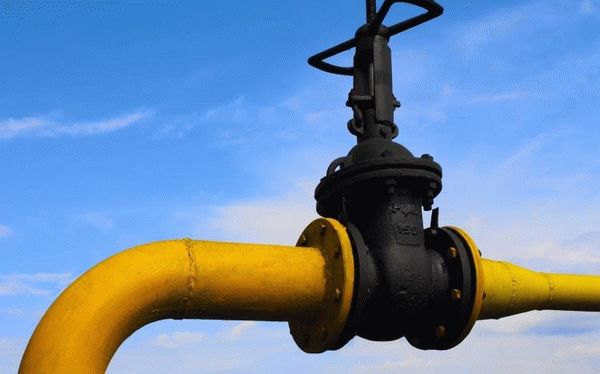
https://youtu.be/Ep9aRGth00Q
Design
Having solved all the issues in GorGaz, your path lies in the design organization, of which there are a huge number today.Attention! When contacting a particular design organization or design institute, be sure to check for a license to perform this type of work.
The difference in the cost of services sometimes reaches from 10 to 50 thousand rubles (i.e. from about $ 280 to $ 1400). But it will be better if you immediately ask GorGaz which design firm they recommend, then there will be fewer problems.
If you need a visit to the house of an engineer - designer, to carry out all the necessary measurements, then please note that this item is stipulated in the contract.
It is with the designer that you agree on the placement of gas appliances in the house and the brand of the desired heating equipment. When the project is ready, the person in charge (designer) will have to agree it with the technical department of GorGaz without fail. This procedure can take from 10 to 14 calendar days.
After completing all the necessary steps described above, you will be able to make calculations and make an approximate estimate of all work in accordance with the project documentation. Next, you draw up a contract for the conduct of technical supervision and provide an act of inspection of chimneys by the VDPO service.
Contract with a construction and installation organization
When all the necessary documents have been signed and all the affairs with GorGaz and the design organization are settled, you are sent to the installation organization, which will subsequently carry out all the necessary construction and installation work. Do not hesitate to check her license as well, since it is the installation organization that must hand over the work to GorGaz, therefore, an entry in the GorGaz register must testify to its existence.
Note: in most cases, installation organizations are licensed to perform not only installation, but also design work, in this case, if you order the implementation of the project directly from the installation organization, then the cost of gasification of the house is reduced by 25-30% of the total amount.
When you have agreed with the installers the timing and cost of the work, be sure to sign an agreement with them, so that in which case you have at least some guarantees from the contractor.
The contract will spell out guarantees and obligations from the installation organization.
Guarantees in the process of laying the external and internal gas pipelines:
- during construction and installation work, the contractor must have all the necessary fire extinguishing means, as well as a protective screen necessary to protect the surface of the walls from heating;
- after the final calculations for the work performed, the installation organization sends you the executive and technical documentation;
- the construction and installation organization undertakes to timely and efficiently perform all work under this contract.
In the process of performing commissioning works:
- to establish optimal modes of gas equipment to ensure the rational use of gas;
- instruct you on the correct operation of the equipment;
- if it is impossible to debug the operation of gas equipment or individual units, establish the reason for such an impossibility to fix it in the act and suspend work until the identified deficiencies are eliminated;
- hand over the result of work with the registration of a bilateral act for the work performed.
List of documents required for connection to the gas pipeline
In order to connect gas to a wooden house, a permit from the gas supplying organization is required. To do this, the owner of a residential building is obliged to provide a package of documentation, which includes:
- Grounding tests carried out by an electrical laboratory;
- Permission for the operation of a gas boiler, issued by the territorial bodies of Rostekhnadzor;
- A gas supply project for the building, preliminarily developed and agreed upon prior to the commencement of work on the installation of gas equipment.
It is important to note that each gas supplying organization develops its own list of documents, the provision of which is necessary to connect to gas. Therefore, it is necessary to clarify this list at the stage of preparation for the installation of equipment, and not after the completion of installation work. This approach will save the owner from unnecessary additional financial and time losses.
Drawing up executive and technical documentation
The installation of the gas pipeline has been completed, as well as all the necessary equipment, then the executive and technical documentation is drawn up, and the installed gas pipeline is accepted by a special commission consisting of their customer, contractor and representative of GorGaz.
The term of acceptance by the commission can be from 14 to 30 working days. If no comments were made, the GorGaz representative will write you a receipt for technical supervision, which you will have to pay and then give a copy to the installation organization. On average, the payment is about 1,500 rubles ($ 43).
Please note that at the time of acceptance, not only must be installed, but also all the equipment listed in the project documentation must be connected. After the commission is completed, the installation organization will prepare and transfer to GorGaz all the necessary technical documentation, where it will be stored.
Based on the decision of the commission and on providing GorGaz with all documents, within 21 working days, the meter will be sealed and an agreement will be concluded with you for the supply of gas, as well as for further maintenance of both the gas pipeline itself and the gas equipment located inside the house.
Gasification process of a private house
Gasification of a private house takes place in several stages.
- The owner's request to the GDO for the preparation of technical specifications for the gas supply of a private house. For this, a standard form approved by Government Decree No. 713 of June 15, 2017 is used. The form indicates basic information about the applicant: full name, postal address, passport data for an individual. The name of the object, its location, the planned value of the hourly consumption of the resource, the terms of commissioning are prescribed.
- Issuance of technical specifications.
- Development of a gasification project for a building - for this purpose, the owner applies to a licensed design organization.
- Conclusion of an agreement according to the standard form for connecting the facility to the gas main with the TU annex. The contract specifies the full name of the GDO, position and full name. performer, full name the applicant. The obligations and responsibilities of the parties to the agreement are prescribed, the conditions for termination and amendment of the agreement are indicated.
- Fulfillment of technical conditions by the parties - taking measures to prepare the gas consumption network and gas-using equipment, drawing up an act on the readiness of the facility for gasification.
- Actual connection of the building to the gas network, drawing up an act on the work performed.
- Conclusion of a contract for the supply of gas. The obligation of the gas distribution company to supply gas to the house around the clock is prescribed, the subscriber is to pay in full for the resource, monitor the health of the equipment, and inform the supplier of information based on the readings of the meter. The price and calculation procedure are indicated.
If during the installation work access to the neighbors' site is required, it is necessary to obtain written consent from all owners or the chairman of the horticultural non-profit partnership.
Safety briefing
When all of the above list of actions is left behind, you will definitely have to undergo safety instructions when using gas.
You can go through the briefing directly in GorGaz, where you will be instructed by a safety engineer, after the briefing, you sign in the journal that remains in GorGaz.
You can also be instructed at home by a certified specialist to conduct safety briefings during the commissioning of gas equipment. You, in the same way as after the briefing in Gorgaz, sign in the TB log, in the future this log will be transferred to GorGaz.
Commissioning works
After starting the gas, you will need to contact the organization with which you signed a service agreement for all provided gas equipment in order for it to activate this equipment. This will be one of the most important conditions for the warranty service of your equipment within the prescribed periods in the warranty service agreement (what warranty period will be established depends on your place of residence, on average, the warranty period for servicing gas equipment is from 1 to 3 years)
You will also need documents to perform a heat engineering calculation, which will help determine the required boiler power to provide heating and hot water supply to a private house (for this, you can contact specialists from housing and communal services):
- floor plans of all heated premises of the house with explication, as well as indication of heights and areas;
- types and number of hot water intake points (such as washstands, bathtubs, showers, etc.);
- a description of the possible use of a gas boiler for technological needs.
The owner of a private house has the right to do all the approvals both independently and to contact an organization that deals with gasification of the house and installation of a gas pipeline.
Privileges
The state identifies a number of categories of citizens in need of social support measures. They are provided with various benefits for utility bills. At the federal level, there are no benefits for connecting a private house to gas. Financial concessions are provided only for payment of the consumed resource.
It is important to know: How often can you change the management company of housing and communal services
However, the local authorities of the regions have the right to determine the categories of citizens and the list of benefits provided within the framework of their regulatory documents. Almost every region provides subsidy for those costs, which were produced during gasification of the house, for the following categories:
- participants, disabled people and widows of participants in the Second World War;
- home front workers;
- residents of besieged Leningrad and underage prisoners of fascist camps;
- disabled people of groups 1 and 2;
- families with three or more children.
Note that in the Leningrad region, for example, the authorities decided to allocate a regional benefit for gasification of private houses in the amount of 110 thousand rubles in the categories listed above. The rest of the population - 70 thousand rubles.
A number of regions stipulate at the level of their regulatory documents the percentage of compensation or benefits from the costs incurred, but limits the upper bar. To find out if a citizen is eligible for a benefit, you must contact the local administration for clarification.
If there is a legal question on the problem of connecting gas in a private house, you can use the form below.
Types of gas pipelines
Now that you have familiarized yourself with the conditions for gasifying your home, consider what types of gas pipelines exist and which one to choose for gasifying your home.
According to their location relative to the surface of the earth, gas pipelines are divided into underground and aboveground, which are distinguished by the method of entering into the building both the internal gas supply networks themselves and risers, which serve to distribute gas to the floors of the house, and all gas-consuming devices.
It is known that the construction of an underground gas pipeline is much more expensive (by about 60%) than an aboveground one. But, nevertheless, such a high cost (1 linear meter of laying an underground gas pipeline costs about 1,300 rubles) does not make the underground gas pipeline less popular.This is due to the fact that a pipe passing through the ground is much more protected than a pipe passing through the air, which means that it will last much longer. Moreover, it is less hazardous to the environment.
During the laying of the underground gas pipeline, it is necessary either to completely block traffic, or to restrict travel on certain sections of the road. To do this, the organization-executor of installation work, on the basis of its design documentation, draws up terrain-specific traffic patterns for both vehicles and pedestrians, as well as the placement of equipment with an indication of the geometric parameters of the desired site and entrances to houses, detours and places of arrangement of road signs.
Schemes for organizing traffic and fencing places for laying the underground gas pipeline are coordinated with the department of the state traffic safety inspectorate (GIBDD), which issues an order for this type of work.
As for the aboveground gas pipeline, it has both advantages and disadvantages. For example, open sections of a gas pipeline are more susceptible to corrosion, and it is easier to connect to such systems without permission. Underground gas pipelines are considered more reliable, but their repair is accompanied by additional costs.
Let's compare two types of gas pipelines in order to make it easier for you to make your choice - which of these types will suit you best:
- if in the area where you live, the soil has high corrosion rates, then in this case it is appropriate to lay the aboveground gas pipeline;
- if a high-voltage power transmission line passes near the place of laying the gas pipeline, then in this case the best option would be to lay an underground gas pipeline;
- if the gas pipeline runs along a neighboring land plot, then in order to avoid damage to the fertile layer of the earth along the entire gas pipeline leading to your house, it is best to choose the laying of an elevated type of gas pipeline, in which case it will be easier to obtain permission from neighbors to lay the gas pipeline along its land plot;
- if you have to lay a gas pipeline across the road, then in this case you can choose a combined option: an underground gas pipeline is laid across the road, and an overground gas pipeline is laid across the land plot.
Gas pipeline material
Now, knowing what types of gas pipelines are, in this part we will consider the question of what types of pipes are used when laying a gas pipeline.
Some 10-15 years ago, pipes for a gas pipeline were made only of steel. Today, polyethylene pipes are in great demand, which not only are not inferior in their properties to steel ones, but also have a number of advantages:
- such pipes are highly resistant to the negative effects of various chemical compounds and environmental factors;
- they are strong and, at the same time, sufficiently flexible, which makes it possible to lay a gas pipeline in regions with particularly severe climatic conditions.
Note: at low temperatures down to -45 degrees, polyethylene does not lose impact strength.
- Since plastic is not a conductor of electric current, such pipes are absolutely insensitive to the effects of stray currents and, therefore, have reliable protection against electrochemical destruction. Therefore, plastic pipes do not need additional protection before laying them in the ground;
- the weight of plastic pipes is 7 times less than that of steel. Moreover, they are delivered in special compact coils, which greatly simplifies their transportation;
- installation of such pipes is simple and convenient;
- The warranty period for plastic pipes is 2 or even 3 times longer than for steel pipes, and is more than 50 years.
Important! the entry of gas pipelines into the house is carried out only with steel pipes, as well as the distribution of the gas pipeline inside the house.
But gas pipelines made of polyethylene pipes have not only advantages, but also restrictions on their use for the construction of gas pipelines, which are stipulated by SNiP 2.04.08-87. Below are some of the restrictions on gas pipeline construction using polyethylene pipes:
- the installation of a gas pipeline from polyethylene pipes is prohibited in areas where the temperature regime of the outside air reaches below minus 45 degrees;
- it is also prohibited to install gas pipelines using polyethylene pipes in areas where seismicity exceeds 6 points;
- the installation of gas pipelines using polyethylene pipes is prohibited both aboveground and aboveground, as well as inside buildings, in tunnels, collectors and canals;
- on land plots where it is planned to arrange crossings over artificial and natural barriers, laying a gas pipeline from polyethylene pipes is also prohibited.
Heating boiler selection
Having considered the issues related to the conditions of gasification of the house, types of gas pipelines, it is necessary to consider another of the equally important issues of gasification - this is the choice of a heating boiler.
As for the choice of a boiler, today the modern market offers many different heating gas boilers. They are subdivided into floor and wall.
A distinctive feature of floor-standing gas boilers is a huge choice of equipment power, which is able to heat more than 150 m2 of premises. With the additional installation of a boiler, the gas boiler will provide maximum hot water supply.
Wall-mounted gas boilers are distinguished, first of all, by their compactness, built-in automatic safety system, the presence of an expansion tank and circulation pumps, as well as a relatively low cost. They are usually designed to heat a room with a total area of up to 150 m2 and provide up to 2 taps with hot water.
Heat exchanger material
As for the material from which heat exchangers in boilers are made, it can be cast iron or steel.
The cast iron heat exchanger is characterized by a long service life (the service life of a gas boiler with a cast iron heat exchanger is 20-25 years, and a boiler with a steel heat exchanger is 10-15 years) due to its high corrosion resistance.
As a rule, the heat exchanger is made of cast iron from sections, which allows, in the event of an accident, not to dismantle the entire boiler, but to isolate only those sections that have been damaged. Keep in mind that a boiler with a cast-iron heat exchanger is highly sensitive to both mechanical and thermal shocks, therefore, make-up with cold water must be carried out only after the heat exchanger has completely cooled down.
A gas boiler with a steel heat exchanger has a much lighter weight and a lower price compared to a boiler with a cast iron heat exchanger. A boiler with such a heat exchanger is not afraid of mechanical stress, but it is prone to corrosion.
Note: a boiler with a cast-iron heat exchanger weighs from 114 kg, and its cost is from 30,000 rubles ($ 845), and a floor-standing boiler with a steel heat exchanger weighs from 60 kg and costs from 12,000 rubles ($ 340).
Non-volatile and volatile boilers
Non-volatile boilers, characterized by natural circulation, have a number of disadvantages: this is the large diameter of the pipeline itself, and the presence of an open expansion tank, and the peculiarities of installing the system with ensuring its slope, but the most important thing is the inability to regulate the air temperature in the room. In this case, the room in which the boiler with an open combustion chamber is supposed to be installed must have both tidal and exhaust ventilation and a chimney.
As for volatile boilers, they have a closed expansion tank, circulation pumps and full electronic boiler control automation.Thus, they can rightfully be considered a mini-boiler room. However, it is necessary to take into account the fact that the uninterrupted operation of the entire heating system must be ensured by a stable mains voltage of 230 ± 10% in the presence of a voltage stabilizer.
Only a specialist can determine the choice of a gas boiler, its capacity, as well as designate a piping scheme and determine the need for additional automation. To calculate the approximate power of a gas boiler, you can make calculations based on the fact that for 10 sq. m of the room requires 1 kW of boiler power + from 15% to 20% of the reserve, designed to extinguish unforeseen heat losses.
With regard to the removal of combustion products in gas boilers, this process can occur either naturally or by force (turbo). In boilers with natural draft, gas is removed by draft in the chimney; in boilers with forced draft - using a fan built into the boiler.
Gas boilers with a "turbo" system, in most cases, are installed at facilities that do not have a traditional chimney. Then the specialists install a coaxial chimney, which is a kind of "pipe in a pipe" that goes out into the street through the wall.
The outer pipe is designed for air supply, and the inner pipe is for the removal of combustion products. A forced draft gas boiler is also installed in a house, where it is undesirable to take air from the room once again.
What you should pay attention to when bringing a coaxial chimney to the street:
- the chimney pipe must be at least 2 m from the ground;
- even during the design of the gas pipeline, if a boiler with a coaxial chimney is installed in your house, you should pay attention to the fact that the exit of combustion products from the boiler does not fall back into the open windows back into the house;
- it should also be noted that condensation can form in the coaxial chimney; to drain the condensate, it is necessary to install a coaxial chimney at an angle of about 2 degrees with a slope to the ground;
- the coaxial chimney must have an unobstructed discharge of combustion products to the street, for this it is necessary that the distance from the end of the outer part of the chimney to the buildings located near the house is at least 1.2 - 1.5 m.
Gasification regulatory documents
The law determines that on a site officially registered as individual housing construction, it is impossible to build houses, the number of storeys above the level of the basement exceeds 3 levels or 12 meters from the ground to the level of the roof ridge.
Even according to the old regulations and laws, restrictions on gasification began only from the 5th floor. Therefore, initially, when discussing above which floor or footage above the ground level, gas should not be carried out, deliberately postponed individual housing construction and began to talk about the possibilities of equipping apartment buildings, starting from the 5th tier.
To begin with, let's figure out the autonomous gas supply.
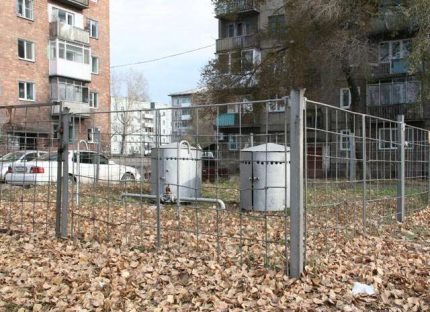

The installation of autonomous gas supply to MKD with the help of tanks is recognized as a reliable source of gas supply. So since 1952 there has not been a single explosion of a properly equipped gas tank.
"Technical regulations on the safety of home gas equipment" in clauses 1.2 and 1.3 states that the supply of fuel from tank installations can be carried out into buildings up to 10 floors, in the case of using group cylinder installations - no more than 5 floors.
That is, autonomous supply is possible from 5 to 10 floors, depending on the type of devices used in the distribution, you will hardly be able to arrange the supply higher.
One of the first documents that normalized the main gas supply of high-rise buildings was SNiP 2.08.01-89 "Residential buildings"... It has a veto on the installation of gas boilers and pipes supplying them above the 5th floor, however, gas stoves are allowed to be installed up to 11.
The document lost its force in 2003 and was replaced by SNiP 31.01.2003 "Residential apartment buildings", by the way, registered as binding at the state level.
But even there it was written that in houses with a height of 11 floors or more, the installation of electrical appliances for cooking is allowed. In this case, boilers with a closed combustion chamber are allowed. By the way, for some reason, many people argue that this document, as well as in 1989, completely prohibited gas supply in high-rise apartment buildings.
It is also surprising that these two documents are still advised and cited as relevant, although both of them have completed their operation.


Please note that, subject to certain conditions and the impossibility of arranging another source, even according to the old SNiP, boilers with a closed combustion chamber were allowed
But instead of them, JVs appeared for 2011 and then for 2020. And just in the updated edition, the clause on the altitude of gasification was abolished altogether. They do not reflect in any way information about the floor on which the supply of "blue" fuel is limited.
And on June 6, 2020, by order of the Ministry of Construction, put into effect SP 402.1325800.2018 Residential buildings. Rules for the design of gas consumption systems "designed for highways in which gas is used as a resource in accordance with GOST 5542 with a pressure of up to 0.005 MPa inclusive. This is just one of those cases when the joint venture is entered into the register as binding.
And you can immediately pay attention to paragraphs 5.16-5.18, which contain instructions for placing gas consumption devices in an MKD with a height of no more than 28 meters. At the same time, there are no prohibitions on installation in excess of this norm. Why exactly 28 meters?
Because the safety regulations are standardized, in houses higher than 28 meters, coordination with the Ministry of Emergency Situations and other structures is required.
Let's see two more documents. SP 60.13330.2012 "Heating, ventilation and air conditioning" and SP 41-108-2004 "Apartment heat supply of residential buildings with gas-fired heat generators" - it is practically stated in plain text that there are no restrictions on gasification of multi-storey residential buildings for 5, 10, 11 floors and above.
That is, in theory, it is officially permitted and possible at the legislative level, if the developer carries out the appropriate approvals and all conditions are met.
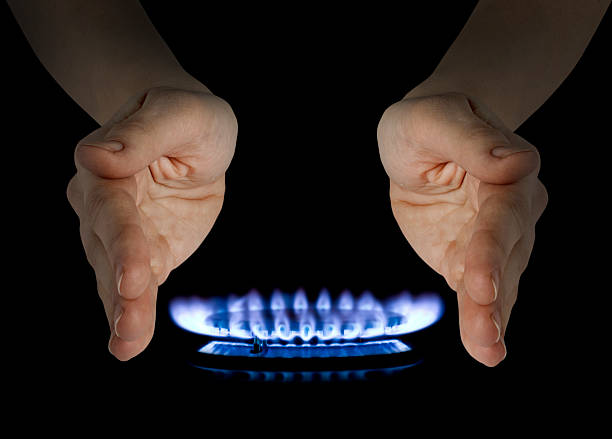

Gasification is officially allowed in every home at the legislative level. But this does not mean at all that every house can be easily gasified at any time.
But in practice, it is problematic to implement the plan, although it is quite possible, especially since modern technical capabilities allow it.
A huge number of nuances still often do not allow the construction of high-rise buildings with gas supply.
Boiler room in the house
As you know, the main condition for the combustion of natural gas is its complete combustion, which occurs only with a sufficient amount of oxygen. Therefore, the parameters of the room must be sufficient for the installation of a gas boiler.
The most suitable place for installing a boiler in a private house can only be, perhaps, a special separate room with a window with a vent or a transom, a chimney, as well as tidal and exhaust ventilation. For air flow, a grill or a special gap with a cross section of at least 0.025 m2 should be provided at the bottom of the door. For boilers with a power of up to 30 kW, an ordinary kitchen can also serve as such a room.
In the room provided for a gas boiler, there must be a water supply system, a drainage ladder and a gas alarm. The latter will help control the microconcentration of carbon monoxide and send a signal to an individual warning system, which, if the set level is exceeded, will cut off the gas supply. An exhaust hood must also be provided in the room.
Main gas in a high-rise building
As a rule, such work is carried out even at the design stage of a high-rise building. However, developers are extremely reluctant to carry out this procedure. And that's why? Let's figure out for a start how the main gas is introduced into the apartments in general.
From the distribution network, the fuel enters the gas pipeline system. From it, it already goes to consumers along the branches. It is far from always possible to supply gas to an ordinary residential building due to overloading of the line.
We have to bypass the nearest input to the gas pipes, often even to the neighboring subscriber network, because the possibilities of the gas pipeline are not limitless, and it is practically unrealistic to supply gas to densely populated areas at the pressure required by law from a single-line position.
According to TU, bypassing obstacles in the fuel supply, sometimes you have to pay literally millions. And here is an apartment building, and even a skyscraper. Imagine the number of subscribers. That is, to supply gas to one such house, a separate main line may be required altogether.
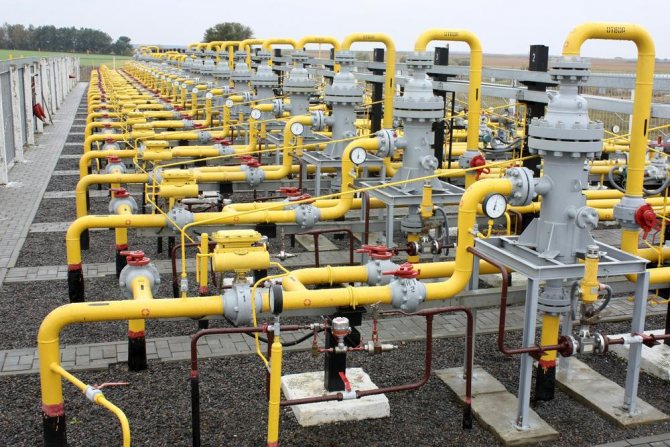

The main gas supply system during construction is usually not calculated for each MKD owner, but only approximately according to the number of possible subscribers. Therefore, for MKD, in densely populated cities, it is necessary to provide an additional line, which is costly in terms of money
But this is not all the "pitfalls". In the regulatory documents, including the aforementioned joint venture introduced on June 6, there are a number of complex technical requirements.
To enter gas into a building, the following conditions must be observed:
- The presence of 2 isolated rooms for the development of the structure of the branches.
- A special ventilation and exhaust system capable of removing waste products from all apartments.
- Corridor ceilings, not less than 1.6 m in height with an increased degree of fire resistance.
- Building design allowing the installation of risers in kitchens and stairwells.
- A large number of valves at each section of the network.
- Equipment for high pressure and its regulation for high-quality apartment gas supply.
- Equipping the windows where the gas equipment is located with an easily ejected glass structure.
- Gas control system on stoves and boilers.
- Emergency dispatch notification.
- Boiler power over 50 kW exclusively in isolated rooms of the apartment.
- The presence of gas sensors with an auto-system for cutting off the gas supply.
In addition, the same "Technical Regulations on the Safety of Household Gas Equipment", but this time without looking back towards gas tanks and cylinder installations, requires supply only to those buildings, the tier of which will provide a practical possibility of eliminating fires.
At the same time, there is an unspoken reservation that it is also possible to equip the local fire-fighting system.
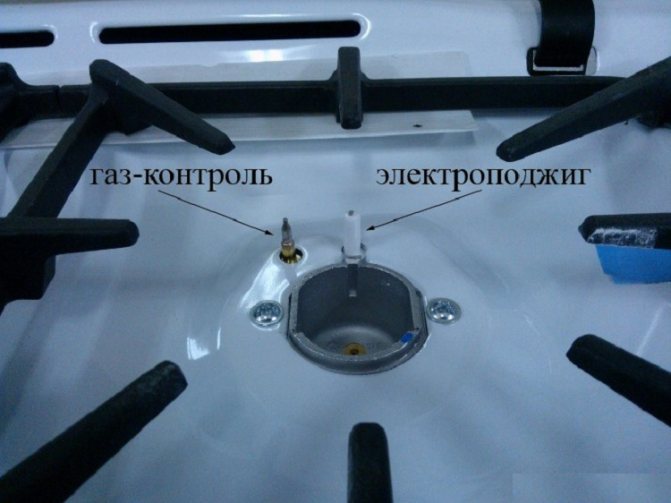

The gas control system shuts off the gas supply to the stove when the burner flame goes out. Acts on the principle of a shut-off valve similar to that found in gas boilers
Thus, partial supply of the high-rise is practically impossible, and the final cost of the work on full gas supply, even at the design stage, will seem prohibitive.
Experts say that it is simply unprofitable and technically difficult to carry out such work within the framework of an ordinary high-rise apartment building.

